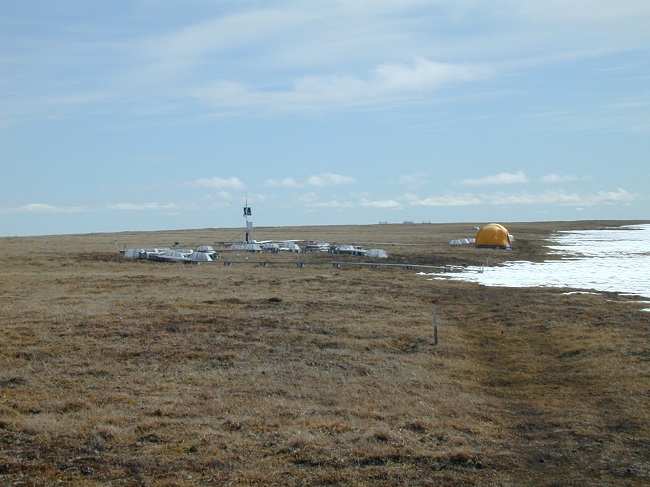The ORNL DAAC recently released a new Arctic-Boreal Vulnerability Experiment (ABoVE) dataset by Huemmrich, K.F., et al. (2022):
Tundra Plant Reflectance, CO2 Exchange, PAM Fluorometry, and Pigments, AK, 2001-2002
This dataset provides measurements at tundra plots collected near Utqiagvik and Atqasuk, AK, including visible-near infrared spectral reflectance, chamber gas exchange measurements of CO2, pulse amplitude modulated (PAM) fluorometry, chlorophyll pigment contents, along with surface temperature, permafrost active layer depth, and soil temperature at 5 cm, through the growing seasons of 2001 and 2002. At all plots, spectral reflectance was measured using a portable spectrometer configured with a straight fiber optic foreoptic, surface temperatures were measured using a handheld Everest Infrared Thermometer, and thaw depth (or active layer depth) was measured using a metal rod graduated in centimeter intervals. At small plots (~15 cm) at Utqiagvik (referred to as Patch plots) chambers were constructed that enclosed an individual patch to determine photosynthetic rate and estimate respiration rate (made by covering the chamber in a dark cloth). Efficiency using PAM fluorometer, ambient yield estimations, and rapid light curve measurements were taken. Chlorophyll concentration was measured with a portable spectrometer configured as a spectrophotometer. At larger plots (approximately 1 m2) which were part of the International Tundra EXperiment (ITEX plots) at Utqiagvik (referred to as Barrow) and Atqasuk, a sub-sample of five control and five warmed plots at each site were fitted with 0.45 m diameter polyvinyl chloride collars for chamber flux measurements. To determine the total fraction of absorbed photosynthetically active radiation (fAPAR), a series of photosynthetically active radiation (PAR) measurements were made using a custom-made light bar consisting of a linear array of GaAsP sensors mounted within an aluminum U-bar under a white plastic diffuser. In addition, a visual estimate was made of the fraction of standing dead vegetation based on percent cover. The data are provided in comma-separated values (*.csv) format. In addition, photographs of plots and instruments are provided.
The ABoVE is a NASA Terrestrial Ecology Program field campaign being conducted in Alaska and western Canada, for 8 to 10 years, starting in 2015. Research for ABoVE links field-based, process-level studies with geospatial data products derived from airborne and satellite sensors, providing a foundation for improving the analysis, and modeling capabilities needed to understand and predict ecosystem responses to, and societal implications of, climate change in the Arctic and Boreal regions.
Additional data from ABoVE and other relevant links can be found on the ORNL DAAC's ABoVE Project Page.
Citation: Huemmrich, K.F., and J.A. Gamon. 2022. Tundra Plant Reflectance, CO2 Exchange, PAM Fluorometry, and Pigments, AK, 2001-2002. ORNL DAAC, Oak Ridge, Tennessee, USA. https://doi.org/10.3334/ORNLDAAC/1960

